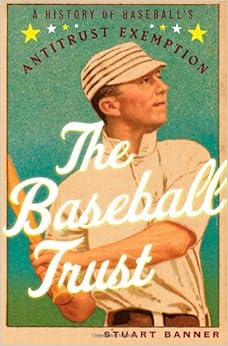Back in 1914 a third major league started called the Federal
League of Base Ball Clubs to provide an alternative to the National League and
the American League. They started off
successfully, and managed to lure both big name players and managers away from
the baseball establishment to add credibility to this upstart Federal League. Still, there were roadblocks put in the way
of personnel movement which resulted in league founder John T. Powers to file an
anti-trust lawsuit against the AL and NL.
The suit was heard by Judge Kenesaw Mountain Landis who stalled long
enough for the Federal League to run out of money and thus no longer pose a
threat to the baseball establishment.
Not coincidentally, Landis later became the Commissioner of Baseball in
recognition for what he’d done to preserve the game (if not free trade).
The dissolution of the Federal League was not a neat and
clean act. Some teams were bought out by
major league teams. Some Federal League
teams were offered the chance to buy major league teams. The Baltimore Terrapins, however, were
excluded from both and decided to bring its own lawsuit claiming that baseball
had violated the Sherman Anti-Trust Act.
Surprisingly they won the verdict and the award of $80,000 was tripled
to $240,000. However, upon appeal the
verdict was overturned and it was heard a third time by US Supreme Court. In 1922 Justice Oliver Wendell Holmes sided
with the Appeal Court and said that baseball did not institute interstate
commerce and was a state’s issue, thus not falling within the definition of
anti-trust outlined in the Sherman legislation.
In 1953 the first major challenge to the exemption was
brought by a minor leaguer in the Yankees organization named George Toolson who
was successfully pitching for the powerhouse organization with no room in the
Bronx for him to play. When the Newark
Bears folded in 1950 the Yankees reassigned him to the single A Binghamton
Triplets. He refused to report, saying that it was
restraint of trade that kept him from signing on with another organization at
the AAA or major league level and that his contract had expired with the
dissolution of the Bears ballclub. It
was felt that with the improvements to the interstate highway system, radio and
television broadcasts that commonly crossed state lines, baseball was indeed an
interstate operation and that the exemption basis from 1922 no longer applied. The Supreme Court upheld the earlier Federal
League ruling.
To this day, baseball enjoys that same interpretation. The most profound impact concerns the
movement of franchises. Unlike Al Davis’
successful challenge that enabled him to move the Raiders from Oakland to Los
Angeles in the NFL, baseball itself must approve all franchise
relocations. There’s currently a
challenge being filed by the City of San Jose who wants to move the Oakland A’s
there. It is similar to other actions
attempted and failed in the past, as the courts have routinely upheld the total
exemption from Anti-Trust legislation for the sport of baseball.
The biggest challenge ever made was the Curt Flood vs. Bowie
Kuhn case filed when Flood was traded without his authorization from the St.
Louis Cardinals to the Philiadelphia Phillies.
He felt that a veteran player should have some say in who was his
employer. Flood lost his challenge and
his options were to play for the Phillies or to retire. He chose to sit out the 1970 season and was
eventually traded to the Washington Senators for whom he played 13 games in
1971 before retiring for good. Six years
later Marvin Miller took a different approach and challenged the reserve clause
through other channels with pitchers Andy Messersmith and Dave McNally. Arbitrator Peter Seitz (hired by the owners) ruled
that players who would complete one year of service without signing a contract
with their current club would void the reserve clause, thus ushering in the concept
of free agency. (Seitz, incidentally,
was immediately fired by the owners who subsequently lost the appeal of his
decision).
It will be interesting to see how things may change under
the new commissioner Rob Manfred.


5 comments:
Las Vegas may apply for a major league franchise. Just kidding, but that would be interesting, to see how the 51s would do in the bigs.
Interesting historical article, Reese.
No, I don't remember the Federal League 1st hand, but had read about it about the time Wm Shea was concocting his Continental League ploy.
Both remind me of Philip Roth's Patriot League from the "Great American Novel" (probably Roth's least known, and wonderfully absurd, book). Anyone else a fan of the Port Ruppert Mundy's ex-con first baseman John Baal, “The Babe Ruth of the Big House,” (who never hit a homerun sober)?
I had considered but then edited out some info about the Continental League as it never saw the light of day. It was to have started in 1961 to include teams in NYC, Denver, Houston, Toronto and Minneapolis. Interestingly, when the major leagues expanded they included two of these cities -- New York and Houston -- and the Minnesota Twins came about when the Washington Senators were allowed to move there. Toronto and Denver would come much later.
excellent post
Reese-
I think Atlanta was in that Continental League mix too. Shea was a genius.
Post a Comment